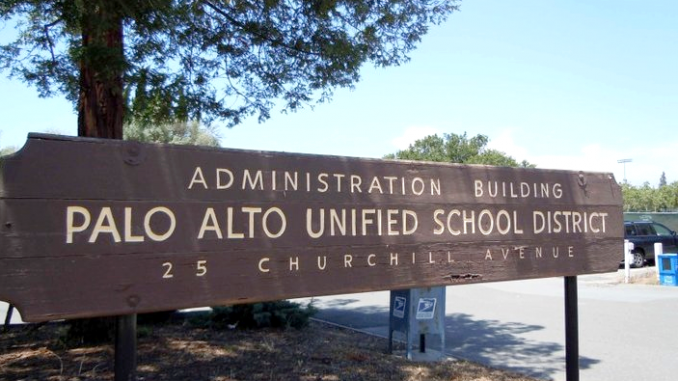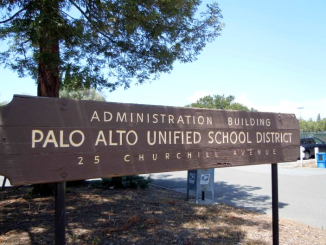
BY ALLISON LEVITSKY
Daily Post Staff Writer
A year after the Palo Alto teachers union refused to return a 3% raise that the school district handed out by mistake, the district has offered the teachers another 2% raise and a 2% one-time bonus for the 2018-19 school year.
“We believe it’s a fair agreement that was also fiscally responsible,” Superintendent Don Austin told the Post. “Our tentative agreement is a positive outcome for PAUSD.”
The raise for the Palo Alto Educators Association would cost taxpayers $1.2 million for the 2018-2019 school year, and thereafter would cost $2.4 million per year. The 2% bonus would cost $2.4 million.
In October, the district and union negotiated an increase in medical, dental and vision benefits for a cost of $440,000.
District leaders didn’t say how the contract would affect unfunded pension liabilities. The district is currently in negotiations for a separate contract with the California School Employees Association Chapter 301, the union that represents classified employees such as clerks, custodians and cafeteria workers.
Many teachers make over $100,000
Palo Alto teachers currently make base salaries ranging between $65,093 and $131,343 per year under a salary schedule approved in May 2016.
According to Transparent California, 46 Palo Alto teachers made salaries higher than that in 2017, ranging from $131,417 to $183,628. With benefits, 59 teachers made more than $170,000 in 2017.
The raises would apply retroactively starting Jan. 7, 2019. The 2% bonus would be applied after the raises kick in.
That means that under the updated salary schedule, the top-earning teachers would make $136,649.26 this year and entry-level teachers would make $67,722.76.
Going forward, the salaries would be set between $66,394.86 and $133,969.86.
Austin said he expects the agreement to come to the school board for a vote at one of the next two board meetings.
The district and the union would reopen the contract next year to discuss compensation for the second year of the three-year contract.
Mistake made with last contract
This is a departure from the last contract, which was approved in 2016 and included a 12% increase over three years.
After that contract was approved, district officials realized they overestimated property tax revenue, leading to a financial crisis.
The school board decided to reopen contract negotiations and walk back the 3% raise and 1% to 2% bonus, but the district’s then-HR chief, Scott Bowers, missed the deadline to do so in March 2017.
After the inadvertent raise made the news in the summer of 2017, board members said it would jeopardize the possibility of future raises. In February 2018, the union gave back the 2% bonus, but kept the 3% raise.
“This still causes a spending issue for subsequent years including, most likely, having to make more budget cuts and not being able to offer raises in the near future, which can hamper our ability to attract new teachers,” then-board member Terry Godfrey said in September 2017.
The inadvertent raise cost the district $4.4 million.
Different bargaining process
This time, the negotiations were made through an interest-based bargaining process for the first time in the district’s history.
Unlike positional bargaining, in which each side meets privately and drafts an offer for the other side to accept or reject, interest-based bargaining involves more direct discussion between the two sides.
There wasn’t a mediator involved in the process, Austin said.
“There were no proposals. Instead it was brainstorming activities and finding interests together,” Austin said. “It’s pretty much the process we just used with Stanford University.”
Austin was referring to the $138.4 million that Stanford has offered the school district to fund the education of the 500 new K-12 students expected to result from the university’s proposed expansion.
Austin said he suggested using interest-based bargaining and it gained “pretty quick enthusiasm,” including from teachers union President Teri Baldwin.
Austin had used interest-based bargaining before, but not in his last job as superintendent of the Palos Verdes Peninsula Unified School District in Los Angeles County.
The process was less hostile than positional bargaining, Austin said, with “great feelings all the way around on both sides.”




So great they are all on the same team!! Who’s watching the kitty though? Not Don Austin. Not the school board. Why didn’t the district divulge any details before this fait accompli? They didn’t want to mess it up for the teacher’s?
Hey Allison, nice anti-teacher tone in the article. Typical of this publication. Why not praise the teachers for giving back a raise they didn’t need to return?
They didn’t give back the raise! They gave back a 2% one-time-only across-the-board bonus, but they kept the raise. They weren’t there for the children when they needed them. Don’t blame the newspaper for simply reporting FACTS.
“Anti-teacher tone”? Give me a break! It’s a fact that when the District was in financial desperate straits and needed the teachers to give back the 3% raise they got, the Union said “no”. Are we supposed to forget about that?
The district was in “financial desperate straits” because of the mistakes the district admin made in projecting their budget and spending money on lawsuits. How quickly one forgets that when looking to point the finger at teachers. The district admin have no one to blame but themselves for this mess.
It’s not pointing fingers when you simply state the facts. The fact is the teachers had a choice — give back the raise or keep it. It’s a simple, binary choice. They decided to keep the money. That’s not pointing fingers.
There were consequences to that decision. A loss of trust in the community was one consequence. The board held out the idea that the teachers wouldn’t get an automatic raise in the future because of that choice, but obviously the board forgot about that promise.
@mendeleev, it’s not anti-teacher to bring up something the teachers did a year ago!
I would be so much more supportive of paying teachers better if we got rid of tenure and had more control over the quality of the teachers. So many are so great, and then there are those that are just terrible.
After many, many years in this district, with multiple kids, schools, and at all levels, my estimate is that 20% of teachers are FANTASTIC, 50% are good-very good, 15% are just acceptable, and about 15% should never be allowed in the classroom again because they are actually harmful to kids.
Raises should not be given the same across the board, and at a minimum, we should be able to get rid of that harmful 15%.
Tenure will never go away or be weakened because of the powerful teachers union. A few years ago, the state teachers union succeeded in killing a bill that would have made it easier to fire teachers for sex crimes. https://www.cnn.com/2012/08/27/us/california-schools-crime-bill/index.html
This says it all about teachers unions!
The teachers are so lousy in the PAUSD that everybody has to hire tutors to help their kids. The teachers don’t know the basics of their subject, but they focus their time on pushing politically correct topics like climate change or social justice down their throats. It’s like a Communist China re-education camp. I think every family that has to hire a tutor should get the tutoring cost refunded from the district by docking the pay of teachers.
(Thank you for letting me post this without censorship. The “other paper” in town wouldn’t allow such a comment to remain on their site for 5 minutes.)